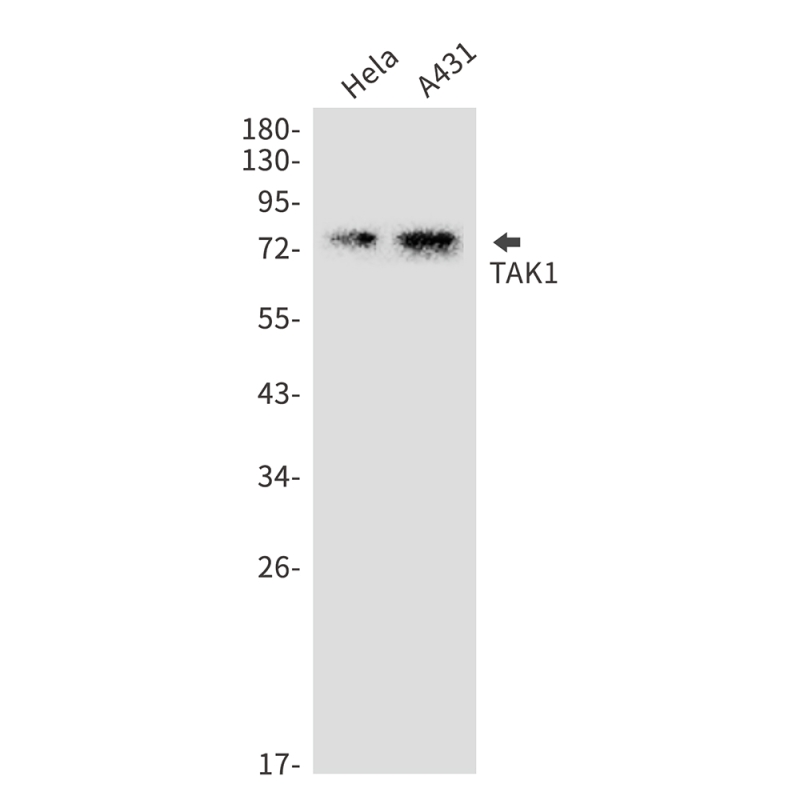
| WB | 1/500-1/1000 | Human,Mouse,Rat |
| IF | 咨询技术 | Human,Mouse,Rat |
| IHC | 1/50-1/100 | Human,Mouse,Rat |
| ICC | 1/50-1/200 | Human,Mouse,Rat |
| FCM | 咨询技术 | Human,Mouse,Rat |
| Elisa | 咨询技术 | Human,Mouse,Rat |
| Aliases | MAP3K7; TAK1; Mitogen-activated protein kinase kinase kinase 7; Transforming growth factor-beta-activated kinase 1; TGF-beta-activated kinase 1 |
| Entrez GeneID | 6885 |
| WB Predicted band size | Calculated MW: 67 kDa; Observed MW: 78 kDa |
| Host/Isotype | Rabbit IgG |
| Antibody Type | Primary antibody |
| Storage | Store at 4°C short term. Aliquot and store at -20°C long term. Avoid freeze/thaw cycles. |
| Species Reactivity | Human |
| Immunogen | A synthetic peptide of human TAK1 |
| Formulation | Purified antibody in TBS with 0.05% sodium azide,0.05%BSA and 50% glycerol. |
+ +
以下是3篇关于TAK1抗体的参考文献及其摘要概括:
1. **"TAK1 mediates the ceramide signaling to stress-activated protein kinase/c-Jun N-terminal kinase"**
*作者:H. Shibuya et al.*
摘要:研究使用TAK1特异性抗体验证了TAK1在神经酰胺诱导的SAPK/JNK信号通路中的核心作用,揭示了其在细胞应激反应中的调控机制。
2. **"TAK1 is essential for keratinocyte growth factor-induced cell survival in human bronchial epithelial cells"**
*作者:S. Sato et al.*
摘要:通过TAK1抗体进行免疫沉淀和Western blot分析,证明TAK1通过激活NF-κB通路介导上皮细胞抗凋亡作用,对呼吸道损伤修复至关重要。
3. **"TAK1 negatively regulates NF-κB and p38 MAP kinase activation in Gr-1+CD11b+ neutrophils"**
*作者:A. A. Ajibade et al.*
摘要:利用TAK1基因敲除小鼠及TAK1磷酸化抗体,揭示TAK1通过调控ROS生成影响中性粒细胞炎症反应,为自身免疫疾病治疗提供新靶点。
4. **"Essential role of TAK1 in regulating Th1 immunity via mTORC1 activation"**
*作者:Y. Wang et al.*
摘要:研究采用TAK1特异性抑制剂及抗体阻断实验,阐明TAK1通过mTORC1通路调控T细胞分化,影响自身免疫性疾病发展机制。
这些文献覆盖了TAK1在炎症、细胞凋亡、免疫调控中的功能研究,均涉及TAK1抗体的实验验证(如Western blot、免疫沉淀)。建议根据具体研究场景进一步筛选。
TAK1 (transforming growth factor β-activated kinase 1) is a serine/threonine kinase belonging to the mitogen-activated protein kinase kinase kinase (MAP3K) family. It plays a pivotal role in regulating diverse cellular processes, including inflammation, immune responses, apoptosis, and cell survival. TAK1 acts as a key mediator in signaling pathways such as NF-κB and MAPK, which are activated by cytokines (e.g., TNF-α, IL-1β), Toll-like receptors (TLRs), and stress signals. Its activation typically requires interaction with adaptor proteins like TAB1. TAB2. or TAB3. leading to phosphorylation of downstream targets like IKK or MKKs. Dysregulation of TAK1 has been linked to cancers, autoimmune diseases, and neurodegenerative disorders.
TAK1 antibodies are essential tools for studying its expression, activation (e.g., phosphorylation at Thr184/187), and interaction partners in experimental models. These antibodies are widely used in techniques such as Western blotting, immunoprecipitation, immunofluorescence, and immunohistochemistry. Commercial TAK1 antibodies are often raised against specific epitopes, such as the N-terminal or kinase domains, and validated for species cross-reactivity (human, mouse, rat). Researchers must select antibodies based on application-specific validation data to ensure specificity, as off-target binding can occur due to homologous kinase domains.
Current research leverages TAK1 antibodies to explore therapeutic targeting, as inhibiting TAK1 may modulate pathological signaling in inflammation-driven diseases or cancer. However, challenges remain in distinguishing between total TAK1 and its activated forms, emphasizing the need for rigorously validated reagents.
×